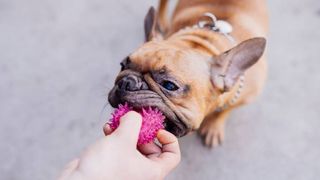Puppy teething timeline: A vet's guide to what to expect and how to help
Is your puppy teething? Let’s look at some of the signs and what you can do to help!

Are you worried about your puppy teething? Teething is something that all pups go through, and the vast majority take it in their stride. That being said, the process of losing their 28 baby teeth and having their 42 adult teeth slowly grow in over a period of several months can be both uncomfortable and painful. Thankfully, there’s plenty you can do to help make the teething phase more bearable for your beloved bundle of fur.
Below, we walk you through each phase of the puppy teething process as well as covering how long teething takes and what you can do to help your pup feel more comfortable. From chew toys to softer food, there are lots of tips and tricks you can employ to help soothe sore and inflamed gums and ensure your little one stays happy and healthy. Let’s take a look…
- Five top teething puppy tips: Keep their teeth tip-top
- Puppy checklist: Nine ways to prepare for your new dog
Stages of puppy teething
Puppies are like people in that they have a set of deciduous (milk or baby) teeth which are later shed and replaced with adult teeth as they grow - here are the main teething stages to be aware of:
- Newborn - Puppies are born without teeth; they don’t require any when they are solely fed by their mother.
- 2 - 4 weeks - Puppies’ teeth start to erupt and break through the gums, at around the same time their eyes and ears start to open. They will still be solely drinking milk at this stage.
- 5 - 6 weeks - Their puppy teeth will be mostly through by now and you can help by offering them soft puppy foods to try and tackle. Puppies will have 28 deciduous (baby) teeth in total.
- 4 - 5 months of age - Dogs start to lose their deciduous teeth around this age – this is the stage of teething that you are most likely to notice. They might be swallowed by your pet, or you might notice them around in the house. Sometimes there is a small amount of bleeding when a tooth is lost. The small incisors at the front of the mouth are usually the first teeth to go, with the larger teeth being later on. We’ll look at how to help your pup manage his teething a bit later on.
- 6 months and older - Your puppy will have lost all his deciduous teeth and will have all 42 of his permanent teeth.
What are the symptoms of a teething puppy?

You may notice your puppy is teething because you find shed baby teeth at home, or perhaps you notice a bit of blood in his food bowl or on his toys. However, there are also some other symptoms to look out for:
- Increased chewing behaviour
- Slower to eat his meals
- Drooling
- Whining or crying a bit more than usual
- Gums appear inflamed
- The emergence of new adult teeth
What behaviours does a teething puppy exhibit?
Puppies that are teething may be chewing more than usual, a bit slower to eat their meals, drool more often and could have inflamed gums. Sometimes you may notice teeth that have been shed in the house or a little bit of bleeding on his chew toys.
What can I give my puppy for teething?
Understandably, you are probably wondering what you can do to help your puppy through the teething process. While some pups just seem to get on with it, others can be downright uncomfortable. Why not try the following to help ease your puppy’s symptoms?
1. Provide plenty of chew toys
If you don’t want your shoes and other possessions chewed, then make sure you are providing your puppy with plenty of chew toys. Give him a variety of textures, some pups like something firm to bite down on, and others want something softer or more textured. Check out our guide to the best puppy teething toys for more inspiration.
2. Frozen toys
Try freezing or chilling some of your pup’s toys. The cool temperature will be very soothing for inflamed gums. Soaking soft or fabric toys in a bit of water first will make them even cooler. Have a look at our homemade puppy teething toys and treats for more ideas.
3. Try feeding softer food
If your puppy is struggling with his normal feed, then increase the proportion of wet food or try soaking his kibbles to soften them. If your puppy’s mouth is sore, he may appreciate this!
4. Puppy proof your home
Make sure your belongings stay safe. Put valuable items out of reach, your shoes away in cupboards or storage chests and limit your puppy’s access to certain parts of your home unless supervised. This will not only keep your dog safe but also your possessions too. Check out our guide to how to puppy proof your house for detailed tips on how to take care of every room in your home.
How long does teething last in puppies?

Teething can last up to 2 months in some puppies. If your dog still has some of his baby teeth beyond 6 months of age, then these could be classed as retained and may need veterinary attention.
Caring for your puppy's teeth
Teeth brushing is an important part of caring for your dog’s teeth and should be performed daily to be most effective. This can be introduced when as a puppy. Begin by letting your pup lick a dog-specific toothpaste from your fingers. These are often meaty flavoured and are lower in fluoride than human pastes. Then let them lick it off a soft bristle brush before you think about any actual brushing.
Keep sessions short, initially and build things up gradually. Have a look at this more detailed guide for further information
You can also keep your puppy’s teeth healthy by avoiding hard treats or chews. Things like bones (cooked or raw), antlers, and some rawhide treats are too hard and could lead to painfully fractured teeth.
How to stop a puppy nipping
If your puppy is teething you may find he wants to chew hands and fingers as well as his toys, but you mustn’t allow him to mouth you in this way. It will cause confusion going forwards and may encourage nipping behaviour. Instead, replace your hands with a chew toy, and praise your pup for playing nicely. Check out our separate guide on how to stop a puppy biting, mouthing or nipping for more information.
Conclusion
Teething is a natural process that all puppies go through. Hopefully, our tips will help keep your pup as comfortable as possible but don’t hesitate to contact your vet if you are worried something doesn’t seem right.
PetsRadar Newsletter
Get the best advice, tips and top tech for your beloved Pets
Dr Rebecca MacMillan is a companion animal vet who has always had a passion for writing and client communication. She works in the South West and loves complex medical cases.

